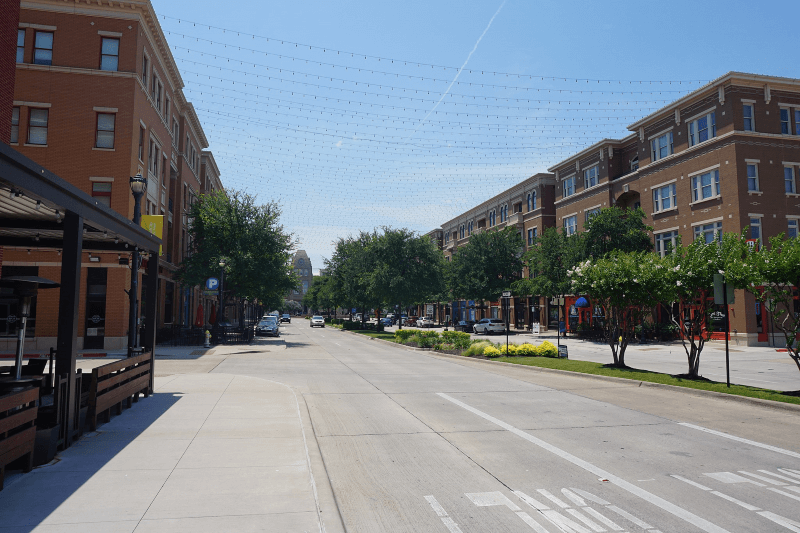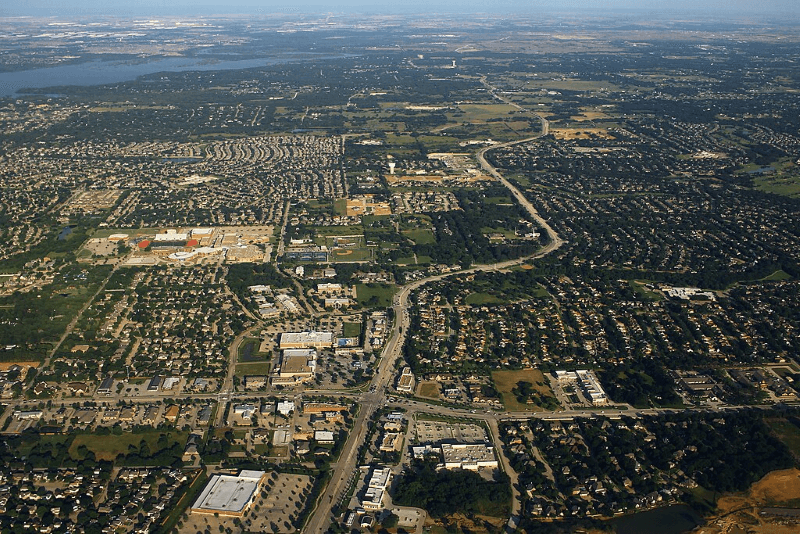
Which cities offer the most opportunities for making the world your office?
To mark Digital Nomad Day on Aug. 8, LawnStarter ranked 2024’s Best Cities for Remote Workers.
We compared nearly 500 of the biggest U.S. cities based on 8 categories. More specifically, we factored in the number of remote job listings, internet access and quality, and incentives for remote workers. We also considered home sizes and access to coworking spaces, among 19 total metrics.
Scroll through our ranking below. To learn how we ranked the cities, see our methodology.
Contents
- City Rankings
- Top 5 Close Up
- Key Insights
- Ask the Experts
- Methodology
- Final Thoughts: Upgrade Your WFH Space
City Rankings
See how each city fared in our ranking:
Top 5 Close Up
Check out the slideshow below for highlights on each of our top 5 WFH-friendly cities.
Key Insights
No income tax saves workers money in 6 states — Alaska, Florida, Nevada, South Dakota, Tennessee, and Texas — in our ranking. From these states, 80 cities score in the top half with quality internet access and numerous remote job opportunities.
Texas is attracting big companies like Chevron to the state in droves for business benefits; meanwhile, remote employees here can reap benefits of their own. Many Lone Star cities have great internet connectivity — some do not, looking at Bryan (No. 440), Laredo (No. 419), and College Station (No. 352)— and fast Wi-Fi speeds.
Coworking spaces are most abundant in big cities across the country. New York (No. 184) enjoys the most, 350, followed by Houston (No. 21) claiming 200, and Los Angeles (No. 238) with 199.
Click through more regional insights below.
Ask the Experts
Some folks work from home, while others are dedicated digital nomads hopping from one city to the next. Whatever the situation, the location of your home base can make a big difference.
We turned to a panel of experts for some teleworking tips. Read their insights below.
- What less obvious advantages are there, if any, to working remotely?
- Beyond traditional benefits — insurance coverage, paid time off, retirement contribution matches — that many employers offer, what non-traditional perks should companies consider giving workers in light of the challenges of working remotely?
- As companies move away from working in traditional offices to remote environments, local economies are likely to be impacted by lower tax revenues from declining commercial real estate and public transit. Where should cities look to replace the lost revenue in both the short and long terms?
- What are the 3 most effective ways for remote workers to stay creative?
- There are many sources offering advice on how to effectively work remotely. What’s the best way to filter “good” advice and tune out the noise?






1. What less obvious advantages are there, if any, to working remotely?
The obvious ones are related to the time we spent commuting to work or juggling different activities in different places (e.g., child care).
We can now do most of our activities from home, diminishing the time we use in moving from one place to the other.
Time is one of those valuable resources that are finite, and this is one of the advantages of flexible work arrangements: People have more control over the structure and management of their time.
For people whose circadian rhythms are not in sync with the 9-to-5 arrangement of our offices and lives, working remotely, and given that they have autonomy to structure their day, provides them with opportunities to adjust their working times to when they are more alert or productive.
Similarly, people who have caregiving responsibilities (e.g., children, elderly relatives, sick friends…) may have more flexibility when organizing and managing all their paid and non-paid work, including household chores.
The problem is that the situation of forced remote work that we are living in affects and drains other resources. We may not have dedicated space for work, or adequate equipment and furniture.
Moreover the lack of physical boundaries between work and personal life requires that people invest more effort and intention on how to manage the now virtual, and psychological boundary, between paid work and other activities.
The research that we are developing at the Worker Wellbeing lab suggests that people are trying to figure out the transition from a sequential and linear home-work-home daily schedule, to a parallel non-sequential structure of our lives in which we are doing laundry while listening to a Zoom meeting, or taking a longer lunch break to help children with online schooling.
Actually, we are finding that people are taking more breaks to manage all their aspects of their lives, but also the paid working time is extended longer than 9 to 5.
2. Beyond traditional benefits — insurance coverage, paid time off, retirement contribution matches — that many employers offer, what non-traditional perks should companies consider giving workers in light of the challenges of working remotely?
Companies should have managers and supervisors that support their employees.
While working remotely, it is extra important that workers perceive that they have all the resources they need to their job. Perceived organizational support is the overall perception that employees form about how much their employers care for their well-being and value their contributions.
Therefore, supervisors and managers should provide their team members with resources and autonomy to manage those resources.
More importantly, for employees to feel supported and valued, managers should focus on building trust with and within the members of their teams.
In addition, we know that this pandemic has affected disproportionally minorities and women because of various reasons. Tangible resources for that can support these employees to manage the extra challenges of the situation (e.g., lack of child care or having household members who are essential workers) are necessary.
These resources are diverse and depend on the situation of each individual, type of company or industry. Having conversations and communication channels that can be used by employees to use their voice in a psychologically safe manner to explain their needs, and following up on these ideas, is key during these times.
It also comes back full circle to the idea of employees feeling that they are supported by their company, and more likely to reciprocate with engagement, productivity and citizenship behaviors.
3. What are the three most effective ways for remote workers to stay creative?
Taking time to reflect on what are you doing, why are you doing it and what do you need to do things in a way that you feel more engaged, satisfied and happy.
4. There are many sources offering advice on how to effectively work remotely. What’s the best way to filter “good” advice and tune out the noise?
Different things work for different people, and trying different things until you find what works for you may be the best route.
Having said that, the advice coming from the American Psychological Association and the Society for Industrial and Organizational Psychology comes from trusted experts who do research and practice in these areas.
5. If you could live anywhere as a remote worker, where would you live and why? And why not be a digital nomad instead of being tied to one location? Beach town in winter, Denver or Maine in summer, for example. Maybe use our best cities for remote workers as a bucket list spending six months in various locations.
It depends on what your needs and responsibilities are. Some people may want to take advantage of this to go back to their hometowns and spend time with their extended families, or going back to their roots.
Some people who do not have any caregiving responsibilities may want to become digital nomads.
Other people who used to travel constantly, may take advantage of enjoying their homes and staying put for a while.
Whatever it is, it should be aligned with our needs and wishes.

1. What less obvious advantages are there, if any, to working remotely?
A couple of things come to mind:
- First, mental health. If we have to juggle many tasks (family for example), if we suffer from solitude, if our home situation is not ideal. These are all factors that make WFH less desirable.
- Second productivity. On the one hand, it is great to have the ability to tailor the day to our needs but a) to some extent, what we do still depends on interactions with others, so inevitably we will still have to have meetings.If meetings online are less productive, then this can translate in lower efficiency.Second, WFH forces us to have much more structured interactions (we have to set up meetings, cannot have extemporaneous interactions), so that can also be detrimental.
2. Beyond traditional benefits — insurance coverage, paid time off, retirement contribution matches — that many employers offer, what non-traditional perks should companies consider giving workers in light of the challenges of working remotely?
Mental health coverage, home office furniture, structure in the day that fosters a separation between work and life (eg protected hours).
Most importantly, a shift in the managerial mindset that rewards people on quality of output rather than hours worked.
3. As companies move away from working in traditional offices to remote environments, local economies are likely to be impacted by lower tax revenues from declining commercial real estate and public transit. Where should cities look to replace the lost revenue in both the short and long terms?
I think the jury is still out on what will happen to cities. Yes, surely in the short run there will be a redistribution, but in my view, the appeal of cities may easily rebound as we get closer to normalcy.
It is very likely that organizations will still try to preserve safe spaces for in-person interactions, maybe located in more suburban areas, maybe larger offices.
So, in my view, there needs to be some flexibility built in because we really do not know where things are going. Surely there will be an appeal for healthier buildings.
4. What are the three most effective ways for remote workers to stay creative?
Find a way to do things that are not immediately related to day by day routines. Set broad goals and work toward ways to achieve them.
I think that the main issue is that WFH it is easier to be either entirely distracted, or entirely pulled into micro tasks for the sake of feeling productive.
Creativity requires a middle ground that does not usually happen if we are constantly glued to our monitors.

1. What less obvious advantages are there, if any, to working remotely?
We know that people have three basic needs that can be met via work: relatedness, autonomy (control over your decisions), and competence.
Working remotely provides a great opportunity to meet the need for autonomy. Maybe you choose when to work, if your job is flexible in that way. Maybe you have more control over your work environment (at-home standing desk, on the patio on a nice day, on the couch). Maybe you have more control over your schedule now that people are meeting face-to-face less.
That’s the biggest benefit. But once COVID passes, working remotely may also help you meet your need for relatedness. You can work in coffee shops, or other public spaces with good internet connections. You can work with people outside of your organization to keep each other motivated in a way that working with colleagues you didn’t necessarily choose might not be able to.
2. Beyond traditional benefits — insurance coverage, paid time off, retirement contribution matches — that many employers offer, what non-traditional perks should companies consider giving workers in light of the challenges of working remotely?
Child-care/elder-care benefits can really help working from home be as productive as possible.
If companies can provide a small stipend to set up an at-home office (e.g., quality desk, quality chair, dual-monitors, better internet) that can help show employees the organization understand the challenges and is providing support, but also can help reduce some of the unnecessary stressors on the worker including something as simple as bad posture from working on the couch or at the dining room table.
A very simple benefit would be increased flexibility in work hours, when possible.
Because working from home means you might be working around your family more frequently, it might be better to start work earlier in the day or later at night.
These flexible hours should not be used to pressure the employee into feeling they need to work more (which is a risk of working remotely) but can be used to make it a more productive experience.
If companies don’t want/can’t give full schedule control to their employees, maybe they set “core hours” from say 11-3 that all employees are online and working, but when to start/stop the workday is up the employee.
3. As companies move away from working in traditional offices to remote environments, local economies are likely to be impacted by lower tax revenues from declining commercial real estate and public transit. Where should cities look to replace the lost revenue in both the short and long terms?
This is definitely out of my wheelhouse since I’m trained only on organizational dynamics.
4. What are the three most effective ways for remote workers to stay creative?
Creativity is linked to positive emotions, opportunity, and drive.
So first, workers need to give themselves some time to be creative intentionally. Set the mood to create those positive emotions. Maybe that’s working out, meditating, or some other personal habit that is not too mentally draining that puts you in a good mood.
Then, let the creativity intentionally flow. Free-write where you just write the thoughts that come to your head, or maybe write in response to specific prompt or idea you want to be creative about, maybe talk to others to be co-creative (but set ground rules that anything goes otherwise the fear of being judged may hinder your creativity).
Then, once your creativity has led to something you want to act on, whether it’s a new way of doing things, an idea for a blog post, or something else, you have to shift gears from letting your mind come up with ideas to focusing in on the one and making it come to life.
This shift can be very challenging, but finding ways to limit distractions can help.
5. There are many sources offering advice on how to effectively work remotely. What’s the best way to filter “good” advice and tune out the noise?
If the advice is based in the scientific literature, then it’s certainly better advice than others. Maybe this is clear because it cites a study, or it’s presented by a professor or a practitioner who has a graduate research degree.
If it sounds too good to be true, though, it probably is. Everything takes work and there is no quick fix.
SIOP.org and SHRM.org are two scientific communities that provide resources for workers and employers that are rooted in the science and backed by the entire field. So you can always go to them for advice, or check the advice you’re getting against that.
Lastly, be afraid of confirmation bias. We all look for information that supports our beliefs or hopes. If you come across advice that you’re really excited about, a quick Google search, or even a quick scholar.google.com search, on that advice can give you input from a bunch of different sources that may disagree with you.
At least then, you can weigh the information, and feel confident that you did your due diligence in researching the topic.

1. What less obvious advantages are there, if any, to working remotely?
So much time is spent at work doing non-productive things like: getting to work (the commute) and dealing with the stress of the commute, especially in urban areas. Time spent in conversations and activities unrelated to work, time spent in coordinating non-work obligations- getting time off for doctors’ appointments, for example.
Not sure if this is obvious or not, but there is more time involved with these than most realize.
2. Beyond traditional benefits — insurance coverage, paid time off, retirement contribution matches — that many employers offer, what non-traditional perks should companies consider giving workers in light of the challenges of working remotely?
For many employees, it’s an issue of technology. They need up-to-date laptops and software. It’s hard to do everything with an iPhone (I know students who take tests for online courses on iPhones).
That’s a basic thing that should be a positive cost/benefit for the company since it would improve productivity.
3. As companies move away from working in traditional offices to remote environments, local economies are likely to be impacted by lower tax revenues from declining commercial real estate and public transit. Where should cities look to replace the lost revenue in both the short and long terms?
Somewhat away from my expertise, a hint might be to look at developing things in short supply now that people want in cities. Also, some cities have seen a resurgence in people moving back, revitalizing inner cities.
More living areas in inner cities mean having more and bigger grocery stores and other things to support people returning. This is what I notice is in such short supply in cities because there just isn’t enough room.
Finally, some creative ideas about economical living areas and arrangements for the homeless would be a great opportunity to address that social problem.
4. What are the three most effective ways for remote workers to stay creative?
Probably depends on the person but having a routine or some (self-imposed) structure to the workday, taking short but frequent breaks, and exercise are all good aspects of staying productive, and they should work for remote work, too.
5. There are many sources offering advice on how to effectively work remotely. What’s the best way to filter “good” advice and tune out the noise?
Follow evidence-based advice. Did you read this advice from a reputable source? Did you hear it from more than one source? Does it make sense to you?

1. What less obvious advantages are there, if any, to working remotely?
None for the employer. For employees, it’s just saving on commuting time.
2. Beyond traditional benefits — insurance coverage, paid time off, retirement contribution matches — that many employers offer, what non-traditional perks should companies consider giving workers in light of the challenges of working remotely?
I think the question for employers is whether they should offset what employees now can’t do at the office, such as go to the company gym. This is only if employers are prohibiting people from working from home.
3. As companies move away from working in traditional offices to remote environments, local economies are likely to be impacted by lower tax revenues from declining commercial real estate and public transit. Where should cities look to replace the lost revenue in both the short and long terms?
No idea, but I don’t agree with the premise that companies will move a lot of jobs permanently out of their offices.
4. There are many sources offering advice on how to effectively work remotely. What’s the best way to filter “good” advice and tune out the noise?
In general, advice from people selling you a solution is less objective.
5. If you could live anywhere as a remote worker, where would you live and why? And why not be a digital nomad instead of being tied to one location? Beach town in winter, Denver or Maine in summer, for example. Maybe use our best cities for remote workers as a bucket list spending six months in various locations.
Not that many people are in a stage of their life where they don’t care about a continuous community. People with children can’t do that, families, important ties to social activities, and so forth can’t hop from one location to another.
The attractions of a location are only one factor that determines where to live. Maintaining more than one residence is really expensive, and it isn’t very feasible to be in transit every few months unless you are running away from something.
Methodology
First, we determined the factors (metrics) that are most relevant to rank the Best Cities for Remote Workers. We then assigned a weight to each factor based on its importance and grouped those factors into 8 categories: Access, Workspace, Financial Incentives, Connectivity, Safety, Affordability, Amenities, and Interest. The categories, factors, and their weights are listed in the table below.
For each of the 500 biggest U.S. cities, we then gathered data on each factor from the sources listed below the table. We eliminated 1 city lacking sufficient data in a single category, resulting in a final sample size of 499 cities.
Finally, we calculated scores (out of 100 points) for each city to determine its rank in each factor, each category, and overall. A city’s Overall Score is the average of its scores across all factors and categories. The highest Overall Score ranked “Best” (No. 1) and the lowest “Worst” (No. 499).
Notes:
- The “Worst” among individual factors may not be No. 499 due to ties.
- “Availability of Personal Workspace” accounts for the median home square footage per average number of household occupants.
- “Internet Costs” and “Utilities Cost” were adjusted to each city’s mean annual income.
Sources: Allconnect, Beyond Menu, BroadbandNow, Caviar, Delivery.com, DoorDash, GrubHub, HighSpeedInternet.com, Indeed, InMyArea.com, Instacart, Federal Housing Finance Agency, Google Ads, MakeMyMove, NeighborhoodScout, Numbeo, Other LawnStarter Studies, Postmates, Seamless, Tax Foundation, Uber Eats, U.S. Census Bureau, U.S. News & World Report, Verizon, and Yelp
Final Thoughts: Upgrade Your WFH Space
While some companies — even Zoom — are mandating a return to work in person, remote work remains popular for many U.S. workers, corroborated by historically low office occupancy rates.
Developers in cities across the country are reimagining offices as apartment complexes to make use of the empty space and help alleviate the housing crisis, with an estimated 55,300 new housing units to be converted from offices this year.
Coworking sites are available to many digital city dwellers who miss their cubicles and coffee breaks. As we face an epidemic of loneliness, coworking offices and pop-up events are crucial opportunities for freelancers and teleworkers to gather — featuring amenities like on-site gyms, childcare, and cafes.
You don’t need another rental to stay sane while working remotely — make the space you have work for you. Untether your career and upgrade your WFH situation with our tips below.
- Make your coworkers jealous by working from a stunning garden:
- Screen in your porch or patio for extra bug bite protection.
- Build or install a shed in your backyard to turn into your office.
- Grow fruit trees and a veggie garden for cooking fresh snacks and meals while working from home.
- Add a pet door to your home so the pups can let themselves out while you’re in a Zoom meeting.
Hire a local LawnStarter crew to handle all your lawn and landscaping needs while you log on for your next Zoom call.
Media Resources
Quotes from LawnStarter editor-in-chief, Jeff Herman
- San Antonio (No. 147) lags behind the rest of the Texas Triangle with fewer remote job opportunities, higher crime rates, and less affordable housing, internet, and utilities.
- Floridians demonstrate the highest interest in remote work. Sunshine State cities claim 7 of the top 10 cities with the highest Google searches for WFH jobs per 100,000 residents, like Kissimmee (No. 217), Orlando (No. 30), and Miami (No. 155).
- Topeka, Kansas (No. 134), has the largest financial incentive to entice remote workers, $11,000. Fayetteville, Arkansas (No. 32), follows with $10,750, and Murfreesboro, Tennessee (No. 54), and Tulsa, Oklahoma (No. 42), tie with an offer worth $10K.
- Honolulu (No. 490) may seem like a fun destination for digital nomads, plus there are 91 coworking spaces to take advantage of. However, the city lands near the bottom of our ranking with few remote job postings and poor 5G, broadband, and fiber internet access. The state also has a high income tax — 11% — and residents have low purchasing power.
- 467 cities have access to 5G internet. New Haven, Connecticut (No. 439), has the slowest average internet speed out of the cities in our ranking. Flower Mound, Texas (No. 4), ties with Chino Hills, California (No. 325), for the best broadband coverage. Texas cities Fort Worth (No. 52), and San Antonio (No. 147), tie for having the most internet service providers.
- Cities like Redmond, Washington (No. 49), Newton, Massachusetts (No. 12), and Bellevue, Washington (No. 50), aren’t only great for remote employees — they offer a high Quality of Life in general for the entire family.
- Why is LawnStarter writing about the Best Cities for Remote Workers? Well, we have an all-remote workplace. We know having strong internet connections, personal connections to colleagues across the miles, and greenspace to decompress and relax all matter.
- High-resolution images of cities
- 2022’s Best Cities for Remote Workers ranking results
- 2023’s Best Cities for Remote Workers ranking results
Main Photo Credit: Mix and Match Studio / Adobe Stock / License




